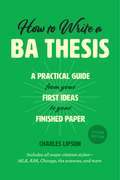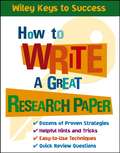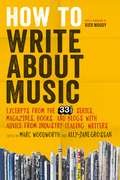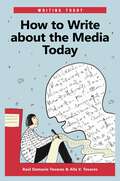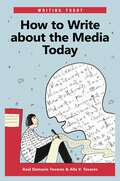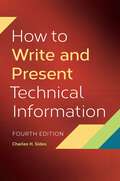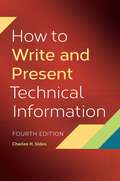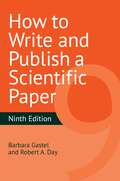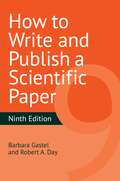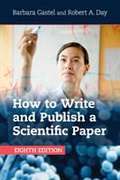- Table View
- List View
How To Write: Revised and Expanded Edition
by Mark Evan SchwartzThere are hundreds of books on the market, all trying to teach you how to write a screenplay. Several of them are excellent and useful books. But never - until now - has there been a screenwriting manual written in the form of a screenplay.Our hero, the aspiring screenwriter Danny, is hopelessly in love with Bebe, a hot young starlet. But Bebe won't go out with Danny until he proves that he can write a brilliant screenplay for her. Helped along the way by a mysterious guide (Virgil) with seemingly magical powers, Danny travels to Screenwriting Hell to see what happens to writers who never make the grade. Virgil teaches him the tricks of the trade, the fundamental techniques that all screenwriters have to master, no matter how great their ideas. But there's something a little strange about Virgil, and Danny is never sure whether to trust him or not...As well as the screenplay itself, the book includes an introduction explaining how to get the most out of the screenplay, the log line, the synopsis, character bios, the treatment, and "The Pitch" - a short scene that shows the author pitching his screenplay to a big-shot producer.
How To Write: Revised and Expanded Edition
by Mark Evan SchwartzThere are hundreds of books on the market, all trying to teach you how to write a screenplay. Several of them are excellent and useful books. But never - until now - has there been a screenwriting manual written in the form of a screenplay.Our hero, the aspiring screenwriter Danny, is hopelessly in love with Bebe, a hot young starlet. But Bebe won't go out with Danny until he proves that he can write a brilliant screenplay for her. Helped along the way by a mysterious guide (Virgil) with seemingly magical powers, Danny travels to Screenwriting Hell to see what happens to writers who never make the grade. Virgil teaches him the tricks of the trade, the fundamental techniques that all screenwriters have to master, no matter how great their ideas. But there's something a little strange about Virgil, and Danny is never sure whether to trust him or not...As well as the screenplay itself, the book includes an introduction explaining how to get the most out of the screenplay, the log line, the synopsis, character bios, the treatment, and "The Pitch" - a short scene that shows the author pitching his screenplay to a big-shot producer.
How to Write a Bestseller: An Insider's Guide to Writing Narrative Nonfiction for General Audiences
by Tilar J MazzeoA bestselling author’s definitive guide to writing and publishing research-based nonfiction for a wide audience Writing fact-based nonfiction for large general audiences requires two different skills: the ability to conduct rigorous research and to craft engaging prose. Tilar J. Mazzeo is one of the few people with extensive experience in both arenas, as a tenured academic and a New York Times bestselling author whose books have been made into a major motion picture and translated into more than fifteen languages. She is also a sought-after writing coach with a passion for helping others communicate their expertise more broadly. In this practical how-to book, Mazzeo draws on her experiences writing and publishing bestsellers to offer an indispensable guide for anyone looking to write narrative nonfiction for a large public audience. In a series of frank and illuminating chapters, she leads readers through the entire process, from conception to publication and beyond. She covers choosing a topic, finding an agent, negotiating a contract, crafting an effective proposal, creating a compelling narrative, marketing one’s work, and developing an author platform. Most importantly, she provides step-by-step advice on how to write prose that will resonate broadly. The ultimate insider’s account, this book will help researchers convey their knowledge effectively so it has impact in the public sphere.
How to Write a BA Thesis: A Practical Guide from Your First Ideas to Your Finished Paper (Chicago Guides to Writing, Editing, and Publishing)
by Charles LipsonThe senior thesis is the capstone of a college education, but writing one can be a daunting prospect. Students need to choose their own topic and select the right adviser. Then they need to work steadily for several months as they research, write, and manage a major independent project. Now there's a mentor to help. How to Write a BA Thesis is a practical, friendly guide written by Charles Lipson, an experienced professor who has guided hundreds of students through the thesis-writing process. This book offers step-by-step advice on how to turn a vague idea into a clearly defined proposal, then a draft paper, and, ultimately, a polished thesis. Lipson also tackles issues beyond the classroom-from good work habits to coping with personal problems that interfere with research and writing. Filled with examples and easy-to-use highlighted tips, the book also includes handy time schedules that show when to begin various tasks and how much time to spend on each. Convenient checklists remind students which steps need special attention, and a detailed appendix, filled with examples, shows how to use the three main citation systems in the humanities and social sciences: MLA, APA, and Chicago. How to Write a BA Thesis will help students work more comfortably and effectively-on their own and with their advisers. Its clear guidelines and sensible advice make it the perfect text for thesis workshops. Students and their advisers will refer again and again to this invaluable resource. From choosing a topic to preparing the final paper, How to Write a BA Thesis helps students turn a daunting prospect into a remarkable achievement.
How to Write a BA Thesis: A Practical Guide from Your First Ideas to Your Finished Paper (Chicago Guides to Writing, Editing, and Publishing)
by Charles LipsonThe senior thesis is the capstone of a college education, but writing one can be a daunting prospect. Students need to choose their own topic and select the right adviser. Then they need to work steadily for several months as they research, write, and manage a major independent project. Now there's a mentor to help. How to Write a BA Thesis is a practical, friendly guide written by Charles Lipson, an experienced professor who has guided hundreds of students through the thesis-writing process. This book offers step-by-step advice on how to turn a vague idea into a clearly defined proposal, then a draft paper, and, ultimately, a polished thesis. Lipson also tackles issues beyond the classroom-from good work habits to coping with personal problems that interfere with research and writing. Filled with examples and easy-to-use highlighted tips, the book also includes handy time schedules that show when to begin various tasks and how much time to spend on each. Convenient checklists remind students which steps need special attention, and a detailed appendix, filled with examples, shows how to use the three main citation systems in the humanities and social sciences: MLA, APA, and Chicago. How to Write a BA Thesis will help students work more comfortably and effectively-on their own and with their advisers. Its clear guidelines and sensible advice make it the perfect text for thesis workshops. Students and their advisers will refer again and again to this invaluable resource. From choosing a topic to preparing the final paper, How to Write a BA Thesis helps students turn a daunting prospect into a remarkable achievement.
How to Write a BA Thesis, Second Edition: A Practical Guide from Your First Ideas to Your Finished Paper (Chicago Guides to Writing, Editing, and Publishing)
by Charles LipsonHow to Write a BA Thesis is the only book that directly addresses the needs of undergraduate students writing a major paper. This book offers step-by-step advice on how to move from early ideas to finished paper. It covers choosing a topic, selecting an advisor, writing a proposal, conducting research, developing an argument, writing and editing the thesis, and making through a defense. Lipson also acknowledges the challenges that arise when tackling such a project, and he offers advice for breaking through writer’s block and juggling school-life demands. This is a must-read for anyone writing a BA thesis, or for anyone who advises these students.
How to Write a BA Thesis, Second Edition: A Practical Guide from Your First Ideas to Your Finished Paper (Chicago Guides to Writing, Editing, and Publishing)
by Charles LipsonHow to Write a BA Thesis is the only book that directly addresses the needs of undergraduate students writing a major paper. This book offers step-by-step advice on how to move from early ideas to finished paper. It covers choosing a topic, selecting an advisor, writing a proposal, conducting research, developing an argument, writing and editing the thesis, and making through a defense. Lipson also acknowledges the challenges that arise when tackling such a project, and he offers advice for breaking through writer’s block and juggling school-life demands. This is a must-read for anyone writing a BA thesis, or for anyone who advises these students.
How to Write a BA Thesis, Second Edition: A Practical Guide from Your First Ideas to Your Finished Paper (Chicago Guides to Writing, Editing, and Publishing)
by Charles LipsonHow to Write a BA Thesis is the only book that directly addresses the needs of undergraduate students writing a major paper. This book offers step-by-step advice on how to move from early ideas to finished paper. It covers choosing a topic, selecting an advisor, writing a proposal, conducting research, developing an argument, writing and editing the thesis, and making through a defense. Lipson also acknowledges the challenges that arise when tackling such a project, and he offers advice for breaking through writer’s block and juggling school-life demands. This is a must-read for anyone writing a BA thesis, or for anyone who advises these students.
How to Write a BA Thesis, Second Edition: A Practical Guide from Your First Ideas to Your Finished Paper (Chicago Guides to Writing, Editing, and Publishing)
by Charles LipsonHow to Write a BA Thesis is the only book that directly addresses the needs of undergraduate students writing a major paper. This book offers step-by-step advice on how to move from early ideas to finished paper. It covers choosing a topic, selecting an advisor, writing a proposal, conducting research, developing an argument, writing and editing the thesis, and making through a defense. Lipson also acknowledges the challenges that arise when tackling such a project, and he offers advice for breaking through writer’s block and juggling school-life demands. This is a must-read for anyone writing a BA thesis, or for anyone who advises these students.
How to Write a Children's Picture Book and Get it Published, 2nd Edition
by Andrea ShavickThis book provides comprehensive advice on what to write about for children, how to write it, and how to present the work professionally for publication. It includes an easy-to-use picture book layout plan and tried and tested examples of title sheets and covering letters. It also includes everything a writer needs to know about the international picture book market and how to sell to agents and publishers.This new edition contains advice on enhancing your text for the ebook market.
How to Write a Great Research Paper
by Book Builders Beverly ChinResearch like a pro-and write a winning paper! Do research papers make you nervous? Don't panic! This task isn't as overwhelming as it may seem--and conducting good research is an important skill to have. With How to Write a Great Research Paper, you'll see how easy and rewarding it can be to explore a topic and present your ideas in an organized and interesting way. Filled with easy-to-follow instructions and valuable tips, this new guide breaks the entire process down into 7 Keys to Success: * Find a Topic * Look It Up * Take Notes * Outline Your Paper * Create Your First Draft * Revise and Edit Your Draft * Present Your Paper So take a deep breath, relax-and get ready to write a top-notch research paper!
How to Write a Pantomime: How To Write And Deliver A Successful Traditional Script (Secrets to Success)
by Lesley CookmanThere are thousands of pantomimes staged throughout the world every year, most of them in Britain. Most groups, whether they be amateur drama societies, schools, Women's Institutes or Village Hall committees are constantly on the lookout for something fresh and original. This is often a matter of economics, as professional pantomimes can be costly in terms of performing rights, let alone the cost of scripts. This book is aimed at those people who take part in this increasingly popular hobby, and at the writer who wishes to write a pantomime, either for a local group, or, indeed, for mass publication.
How to Write a Poem (How to Study Literature)
by John RedmondAn innovative introduction to writing poetry designed for students of creative writing and budding poets alike. Challenges the reader’s sense of what is possible in a poem. Traces the history and highlights the potential of poetry. Focuses on the fundamental principles of poetic construction, such as: Who is speaking? Who are they speaking to? Why does their speaking take this form? Considers both experimental and mainstream approaches to contemporary poetry. Consists of fourteen chapters, making it suitable for use over one semester. Encourages readers to experiment with their poetry.
How to Write About Music: Excerpts from the 33 1/3 Series, Magazines, Books and Blogs with Advice from Industry-leading Writers
by Marc Woodworth Ally-Jane GrossanIf writing about music is like dancing about architecture, you'd do best to hone your chops and avoid clichés (like the one that begins this sentence) by learning from the prime movers. How to Write About Music offers a selection of the best writers on what is perhaps our most universally beloved art form. Selections from the critically-acclaimed 33 1/3 series appear alongside new interviews and insights from authors like Lester Bangs, Chuck Klosterman, Owen Pallet, Ann Powers and Alex Ross.How to Write About Music includes primary sources of inspiration from a variety of go-to genres such as the album review, the personal essay, the blog post and the interview along with tips, writing prompts and advice from the writers themselves.Music critics of the past and the present offer inspiration through their work on artists like Black Sabbath, Daft Punk, J Dilla, Joy Division, Kanye West, Neutral Milk Hotel, Radiohead, Pussy Riot and countless others. How to Write About Music is an invaluable text for all those who have ever dreamed of getting their music writing published and a pleasure for everyone who loves to read about music.
How to Write About Music: Excerpts from the 33 1/3 Series, Magazines, Books and Blogs with Advice from Industry-leading Writers
by Marc Woodworth Ally-Jane GrossanIf writing about music is like dancing about architecture, you'd do best to hone your chops and avoid clichés (like the one that begins this sentence) by learning from the prime movers. How to Write About Music offers a selection of the best writers on what is perhaps our most universally beloved art form. Selections from the critically-acclaimed 33 1/3 series appear alongside new interviews and insights from authors like Lester Bangs, Chuck Klosterman, Owen Pallet, Ann Powers and Alex Ross.How to Write About Music includes primary sources of inspiration from a variety of go-to genres such as the album review, the personal essay, the blog post and the interview along with tips, writing prompts and advice from the writers themselves.Music critics of the past and the present offer inspiration through their work on artists like Black Sabbath, Daft Punk, J Dilla, Joy Division, Kanye West, Neutral Milk Hotel, Radiohead, Pussy Riot and countless others. How to Write About Music is an invaluable text for all those who have ever dreamed of getting their music writing published and a pleasure for everyone who loves to read about music.
How to Write about the Media Today (Writing Today)
by Raúl Damacio Tovares Alla V. TovaresA comprehensive and practical guide to writing a successful media paper or report, from selecting a topic to submitting the final draft.How to Write about the Media Today is the first book to offer students and media practitioners a comprehensive approach for researching and preparing a report, paper, or presentation on some aspect of today's mass communication. How to Write about the Media Today begins with a discussion of different types of media outlets—from traditional newspapers and television to the Internet—as well as an overview of contemporary directions in media studies. This is followed by a series of step-by-step strategies for selecting topics, conducting research, and writing cogently and engagingly about media-related events and issues. Because each chapter stands on its own, this resource can be read sequentially or consulted topic-by-topic as needed.
How to Write about the Media Today (Writing Today)
by Raúl Damacio Tovares Alla V. TovaresA comprehensive and practical guide to writing a successful media paper or report, from selecting a topic to submitting the final draft.How to Write about the Media Today is the first book to offer students and media practitioners a comprehensive approach for researching and preparing a report, paper, or presentation on some aspect of today's mass communication. How to Write about the Media Today begins with a discussion of different types of media outlets—from traditional newspapers and television to the Internet—as well as an overview of contemporary directions in media studies. This is followed by a series of step-by-step strategies for selecting topics, conducting research, and writing cogently and engagingly about media-related events and issues. Because each chapter stands on its own, this resource can be read sequentially or consulted topic-by-topic as needed.
How to Write About Theatre: A Manual for Critics, Students and Bloggers
by Mark FisherWhat do you do if you find yourself weeping in the stalls? How should you react to Jude Law's trousers or David Tennant's hair? Are you prepared to receive toilet paper in the post? What if the show you just damned turns out to be a classic? If you gave it a five-star rave will anyone believe you?Drawing on his long years of experience as a national newspaper critic, Mark Fisher answers such questions with candour, wit and insight. Learning lessons from history's leading critics and taking examples from around the world, he gives practical advice about how to celebrate, analyse and discuss this most ephemeral of art forms - and how to make your writing come alive as you do so.Today, more people than ever are writing about theatre, but whether you're blogging, tweeting or writing an academic essay, your challenges as a critic remain the same: how to capture a performance in words, how to express your opinions and how to keep the reader entertained. This inspirational book shows you the way to do it.Foreword by Chris Jones, Chief theater critic, Chicago Tribune
How to Write About Theatre: A Manual for Critics, Students and Bloggers
by Mark FisherWhat do you do if you find yourself weeping in the stalls? How should you react to Jude Law's trousers or David Tennant's hair? Are you prepared to receive toilet paper in the post? What if the show you just damned turns out to be a classic? If you gave it a five-star rave will anyone believe you?Drawing on his long years of experience as a national newspaper critic, Mark Fisher answers such questions with candour, wit and insight. Learning lessons from history's leading critics and taking examples from around the world, he gives practical advice about how to celebrate, analyse and discuss this most ephemeral of art forms - and how to make your writing come alive as you do so.Today, more people than ever are writing about theatre, but whether you're blogging, tweeting or writing an academic essay, your challenges as a critic remain the same: how to capture a performance in words, how to express your opinions and how to keep the reader entertained. This inspirational book shows you the way to do it.Foreword by Chris Jones, Chief theater critic, Chicago Tribune
How to Write and Present Technical Information
by Charles H. SidesThoroughly updated to discuss the use of tools such as Skype and social media, this concise volume shows how effective communication—via written text and spoken presentations—can positively impact project management in professional environments.Professional communications are the "information product" of all organizations and businesses. Based on that premise, this book offers communications strategies that will benefit any organization that disseminates technical information in-house and/or to customers. The popular work provides easy-to-understand and apply guidelines for designing and writing effective technical documents, as well as other related communications. What makes this new edition especially valuable is that it maintains the quality of information that distinguished the previous editions, but is now updated to encompass current technology and trends, including today's prevalent communication tools such as social media.The book begins by looking at skills common to all technical writing and offering general advice on designing and writing reports. Next is a discussion of specific types of reports along with common problems and issues writers face. Finally, the work overviews other forms of communications such as professional presentations. The updated material also considers the growing importance of interviews and focus groups as information-gathering tools, the influence of visual rhetoric, and the use of technologies such as Skype and webinars.
How to Write and Present Technical Information
by Charles H. SidesThoroughly updated to discuss the use of tools such as Skype and social media, this concise volume shows how effective communication—via written text and spoken presentations—can positively impact project management in professional environments.Professional communications are the "information product" of all organizations and businesses. Based on that premise, this book offers communications strategies that will benefit any organization that disseminates technical information in-house and/or to customers. The popular work provides easy-to-understand and apply guidelines for designing and writing effective technical documents, as well as other related communications. What makes this new edition especially valuable is that it maintains the quality of information that distinguished the previous editions, but is now updated to encompass current technology and trends, including today's prevalent communication tools such as social media.The book begins by looking at skills common to all technical writing and offering general advice on designing and writing reports. Next is a discussion of specific types of reports along with common problems and issues writers face. Finally, the work overviews other forms of communications such as professional presentations. The updated material also considers the growing importance of interviews and focus groups as information-gathering tools, the influence of visual rhetoric, and the use of technologies such as Skype and webinars.
How to Write and Publish a Scientific Paper
by Barbara Gastel Robert A. DayThoroughly updated throughout, this classic, practical text on how to write and publish a scientific paper takes its own advice to be "as clear and simple as possible.""The purpose of scientific writing," according to Barbara Gastel and Robert A. Day, "is to communicate new scientific findings. Science is simply too important to be communicated in anything other than words of certain meaning."This clear, beautifully written, and often funny text is a must-have for anyone who needs to communicate scientific information, whether they're writing for a professor, other scientists, or the general public. The thoughtfully revised 9th edition retains the most important material-including preparing text and graphics, publishing papers and other types of writing, and plenty of information on writing style-while adding up-to-date advice on copyright, presenting online, identifying authors, creating visual abstracts, and writing in English as a non-native language.A set of valuable appendixes provide ready reference, including words and expressions to avoid, SI prefixes, a list of helpful websites, and a glossary. Students and working scientists will want to keep How to Write and Publish a Scientific Paper at their desks and refer to it at every stage of writing and publication.
How to Write and Publish a Scientific Paper
by Barbara Gastel Robert A. DayThoroughly updated throughout, this classic, practical text on how to write and publish a scientific paper takes its own advice to be "as clear and simple as possible.""The purpose of scientific writing," according to Barbara Gastel and Robert A. Day, "is to communicate new scientific findings. Science is simply too important to be communicated in anything other than words of certain meaning."This clear, beautifully written, and often funny text is a must-have for anyone who needs to communicate scientific information, whether they're writing for a professor, other scientists, or the general public. The thoughtfully revised 9th edition retains the most important material-including preparing text and graphics, publishing papers and other types of writing, and plenty of information on writing style-while adding up-to-date advice on copyright, presenting online, identifying authors, creating visual abstracts, and writing in English as a non-native language.A set of valuable appendixes provide ready reference, including words and expressions to avoid, SI prefixes, a list of helpful websites, and a glossary. Students and working scientists will want to keep How to Write and Publish a Scientific Paper at their desks and refer to it at every stage of writing and publication.
How to Write and Publish a Scientific Paper (Eighth Edition) (PDF)
by Robert Day Barbara GastelAn essential guide for succeeding in today's competitive environment, this book provides beginning scientists and experienced researchers with practical advice on writing about their work and getting published. This brand new, updated edition also includes a new chapter on editing one's own work, a section on publicizing and archiving one's paper, and updates on authorship, including information on new authorship criteria and on the author identification number ORCID. The book guides readers through the processes involved in writing for and publishing in scientific journals, from choosing a suitable journal, to writing each part of the paper, to submitting the paper and responding to peer review, through checking the proofs. It covers ethical issues in scientific publishing, explains rights and permissions, and discusses writing grant proposals, giving presentations and writing for general audiences.
How to Write Better Essays (Palgrave Study Skills) (PDF)
by Bryan GreethamHave you ever wondered why some people can produce a well-structured, relevant essay written in a style that seems to glide across the page with the minimum of fuss? Do you think some people simply have these skills, and others don't, and that there is nothing we can do about it? This book just might change your mind. Addressing each landmark stage of the essay writing process, How to Write Better Essays teaches you how to... * analyse the question and break down difficult terms and concepts * brainstorm effectively and generate your own ideas * evaluate and criticise arguments * express your thoughts coherently and develop your own style of writing * plan and structure your essay from introduction to conclusion ... and along the way, practical techniques show how to analyse, criticise, discuss and evaluate material, improve your style, revise your final draft and avoid plagiarism. The third edition of this bestselling book includes new chapters on critical thinking, tackling reflective writing assignments, and how to create and analyse concepts. It also features a new companion website providing annotated essays to illustrate the successful outcome of the methods you learn in the book, exercises to develop critical thinking skills, and additional examples of how to analyse concepts. For every student who needs to write essays, from whatever discipline, this book is a constant source of the help and inspiration you need to tackle your essays with confidence.



